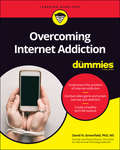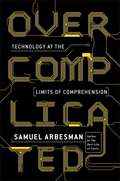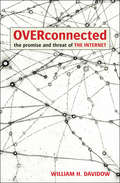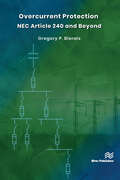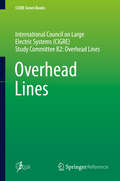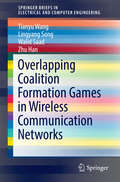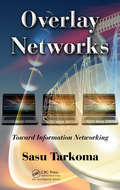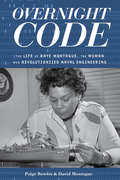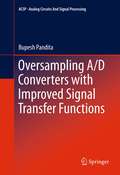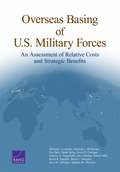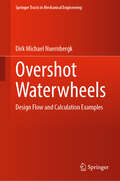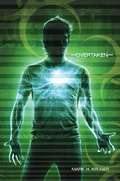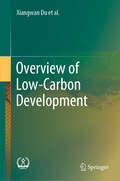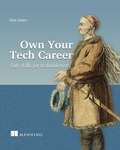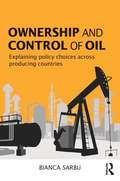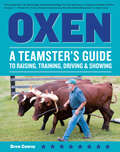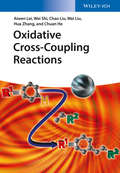- Table View
- List View
Overcoming Internet Addiction For Dummies
by David N. GreenfieldA guidebook to beating internet addiction and screen overuse and for living a fuller life There’s no escaping it―we live in a digital world. We work, play, socialize, and learn online, and the Internet provides many amazing opportunities. Unfortunately, because of our basic biology, we’re all susceptible to overuse and addiction to screens. Video games, social media, porn, and even scrolling online, taps into that pleasurable dopamine reward system. So, when is it time to log off or put the phone down and get help? Overcoming Internet Addiction For Dummies gives you the information, resources, and the self-assessment tools you need to discover how much is too much, along with practical suggestions on what to do about it. Learn how to take back control of your time and attention—or help your kids or loved ones get control of theirs. This comprehensive, user-friendly overview of Internet addiction is full of helpful and proven methods to help foster a healthy, balanced, and sustainable life with screens. Discover the basic biology of addiction, including why children and teens are especially susceptible. Become aware of the cognitive, psychological, and physical effects excess Internet and screen use. Learn how social media, video gaming, and Internet pornography could be getting in the way of real-time living. Find out why smartphones are not smart for you to use all the time. Understand the science of how and why you can become addicted to your screens so you can unplug more easily and use your time for what matters most. Empower yourself and your children to build a positive relationship with the Internet and digital technology. This book can help you and your loved ones plug back into life and show you where you can find information, resources, support, and treatment. Overcoming Internet Addiction is about taking back control of your time and attention and learning to manage your screen use, so it doesn’t manage you.
Overcomplicated: Technology at the Limits of Comprehension
by Samuel ArbesmanWhy did the New York Stock Exchange suspend trading without warning on July 8, 2015? Why did certain Toyota vehicles accelerate uncontrollably against the will of their drivers? Why does the programming inside our airplanes occasionally surprise its creators? After a thorough analysis by the top experts, the answers still elude us. You don't understand the software running your car or your iPhone. But here's a secret: neither do the geniuses at Apple or the Ph.D.'s at Toyota--not perfectly, anyway. No one, not lawyers, doctors, accountants, or policy makers, fully grasps the rules governing your tax return, your retirement account, or your hospital's medical machinery. The same technological advances that have simplified our lives have made the systems governing our lives incomprehensible, unpredictable, and overcomplicated. In Overcomplicated, complexity scientist Samuel Arbesman offers a fresh, insightful field guide to living with complex technologies that defy human comprehension. As technology grows more complex, Arbesman argues, its behavior mimics the vagaries of the natural world more than it conforms to a mathematical model. If we are to survive and thrive in this new age, we must abandon our need for governing principles and rules and accept the chaos. By embracing and observing the freak accidents and flukes that disrupt our lives, we can gain valuable clues about how our algorithms really work. What's more, we will become better thinkers, scientists, and innovators as a result. Lucid and energizing, this book is a vital new analysis of the world heralded as "modern" for anyone who wants to live wisely.
Overcomplicated: Technology at the Limits of Comprehension
by Samuel ArbesmanWhy did the New York Stock Exchange suspend trading without warning on July 8, 2015? Why did certain Toyota vehicles accelerate uncontrollably against the will of their drivers? Why does the programming inside our airplanes occasionally surprise its creators? After a thorough analysis by the top experts, the answers still elude us. You don’t understand the software running your car or your iPhone. But here’s a secret: neither do the geniuses at Apple or the Ph.D.’s at Toyota—not perfectly, anyway. No one, not lawyers, doctors, accountants, or policy makers, fully grasps the rules governing your tax return, your retirement account, or your hospital’s medical machinery. The same technological advances that have simplified our lives have made the systems governing our lives incomprehensible, unpredictable, and overcomplicated. In Overcomplicated, complexity scientist Samuel Arbesman offers a fresh, insightful field guide to living with complex technologies that defy human comprehension. As technology grows more complex, Arbesman argues, its behavior mimics the vagaries of the natural world more than it conforms to a mathematical model. If we are to survive and thrive in this new age, we must abandon our need for governing principles and rules and accept the chaos. By embracing and observing the freak accidents and flukes that disrupt our lives, we can gain valuable clues about how our algorithms really work. What’s more, we will become better thinkers, scientists, and innovators as a result. Lucid and energizing, this book is a vital new analysis of the world heralded as "modern" for anyone who wants to live wisely.
Overcomplicated: Technology at the Limits of Comprehension
by Samuel ArbesmanWhy did the New York Stock Exchange suspend trading without warning on July 8, 2015? Why did certain Toyota vehicles accelerate uncontrollably against the will of their drivers? Why does the programming inside our airplanes occasionally surprise its creators? After a thorough analysis by the top experts, the answers still elude us. You don't understand the software running your car or your iPhone. But here's a secret: neither do the geniuses at Apple or the Ph.D.'s at Toyota--not perfectly, anyway. No one, not lawyers, doctors, accountants, or policy makers, fully grasps the rules governing your tax return, your retirement account, or your hospital's medical machinery. The same technological advances that have simplified our lives have made the systems governing our lives incomprehensible, unpredictable, and overcomplicated. In Overcomplicated, complexity scientist Samuel Arbesman offers a fresh, insightful field guide to living with complex technologies that defy human comprehension. As technology grows more complex, Arbesman argues, its behavior mimics the vagaries of the natural world more than it conforms to a mathematical model. If we are to survive and thrive in this new age, we must abandon our need for governing principles and rules and accept the chaos. By embracing and observing the freak accidents and flukes that disrupt our lives, we can gain valuable clues about how our algorithms really work. What's more, we will become better thinkers, scientists, and innovators as a result. Lucid and energizing, this book is a vital new analysis of the world heralded as "modern" for anyone who wants to live wisely. From the Hardcover edition.
Overconnected: The Promise and Threat of the Internet
by William H. Davidow&“Shows how the unanticipated effects of the Internet are distorting economics, politics, international relations, and individual lives&” (James Fallows). In Overconnected, Bill Davidow, a former Silicon Valley executive, explains how the almost miraculous success of the Internet has also created a unique set of hazards, in effect overconnecting us, with the direst of consequences for our political, economic, and day-to-day lives. The practical applications—not least among them the ability to borrow money, invest in the stock market, or buy a new home—have made a great impact in our daily lives. But the luxuries of the connected age have taken on a momentum all of their own, ultimately becoming the root cause of a financial meltdown from which much of the world is now still struggling to recover. By meticulously and counter-intuitively anatomizing how being overconnected tends to create systems of positive feedback that have largely negative consequences, Davidow explains everything from the subprime-mortgage crisis to the meltdown of Iceland, from the loss of people&’s privacy to the spectacular fall of the stock market that forced the Federal Government to rescue institutions supposedly &“too big to fail.&” All because we were so miraculously wired together! Explaining how such symptoms of Internet connection as unforeseeable accidents and thought contagions acted to accelerate the downfall and make us permanently vulnerable to catastrophe, Davidow places our recent experience in historical perspective and offers a set of practical steps to minimize similar disasters in the future. Original, commonsensical and historically informed, Overconnected indentifies problems we live with that are now so large, omnipresent and part of our daily lives that few people have even noticed them.
Overcurrent Protection NEC Article 240 and Beyond
by Gregory P. BieralsAn overcurrent is caused by a short-circuit, ground-fault, or an overload. A short-circuit may be hundreds or even thousands of times above the normal operating current. This type of fault may be an arcing fault between ungrounded conductors or between an ungrounded conductor and a grounded (usually, a neutral) conductor, a line-to-line arcing fault may produce a current of 74% of a 3-phase bolted fault. A line-to-neutral arcing fault will be somewhat less. A line-to-line bolted fault, the equivalent, of the conductors bolted together, may be up to 100% of the available short-circuit current. A line-to-neutral bolted fault may be in excess of 100% of the 3-phase bolted fault at the source, but considerably less downstream. A ground-fault, that is, the equivalent of a connection between an ungrounded conductor and the equipment grounding system, will produce a current that may be 38% or higher of the 3-phase bolted fault current. These types of faults are typically arcing faults which normally are intermittent in nature. That is, they strike and restrike over time and may produce a short-circuit fault due to insulation damage. Once again, a line-to-equipment ground fault near the source may produce a fault current of over 100% of the 3-phase bolted fault, but considerably less downstream. An overload typically ranges from one to six times the normal current, and are normally caused by motor starting currents or transformer magnetizing currents. These conditions are of such short duration that the circuit components are not damaged. This book has a detailed analysis of these types of faults, along with explanations and examples of the various types of overcurrent protective devices to assure proper protection. This volume has extensive information on the application of overcurrent protection for conductors and equipment. The reader will be able to calculate fault currents as well as establishing the short-circuit withstand rating of conductor insulation and to determine the appropriate type of overcurrent devices based on circuit conditions. In addition, determining ground-fault currents for the purpose of selecting the proper size of equipment grounding conductors to establish an effective ground-fault current path is discussed in detail. Readership - Anyone involved with the design of overcurrent protection for electrical distribution systems from the system source to the electrical utilization equipment. The emphasis is placed on the design of the overcurrent protection for specific installations to assure proper protection for the circuit components regardless of the type of fault encountered.
Overhead Lines
by Konstantin O. PapailiouThis handbook offers all aspects of Overhead Transmission Lines as the backbone of networks of electrical power. The content of the book includes, after a historical flash-back: Planning and management concepts, electrical and mechanical considerations, influences of the weather, and on the environment, detailed design of all line components, construction and maintenance aspects, line optimization, and asset management, as well as a comparison between overhead lines and underground cables. The book was written by more than 50 experts and assembled through the Cigr#65533; study committee on Overhead Lines. This guarantees valuable exchange and dissemination of unbiased information for technical but also non-technical audiences.
Overlapping Coalition Formation Games in Wireless Communication Networks
by Zhu Han Walid Saad Tianyu Wang Lingyang SongThis brief introduces overlapping coalition formation games (OCF games), a novel mathematical framework from cooperative game theory that can be used to model, design and analyze cooperative scenarios in future wireless communication networks. The concepts of OCF games are explained, and several algorithmic aspects are studied. In addition, several major application scenarios are discussed. These applications are drawn from a variety of fields that include radio resource allocation in dense wireless networks, cooperative spectrum sensing for cognitive radio networks, and resource management for crowd sourcing. For each application, the use of OCF games is discussed in detail in order to show how this framework can be used to solve relevant wireless networking problems. Overlapping Coalition Formation Games in Wireless Communication Networks provides researchers, students and practitioners with a concise overview of existing works in this emerging area, exploring the relevant fundamental theories, key techniques, and significant applications.
Overlay Networks: Toward Information Networking.
by Sasu TarkomaWith their ability to solve problems in massive information distribution and processing, while keeping scaling costs low, overlay systems represent a rapidly growing area of R&D with important implications for the evolution of Internet architecture. Inspired by the author's articles on content based routing, Overlay Networks: Toward Information
Overnight Code: The Life of Raye Montague, the Woman Who Revolutionized Naval Engineering
by Paige Bowers David MontagueOvernight Code tells the story of Raye Montague, an ambitious little girl from segregated Little Rock who spent a lifetime educating herself, both inside and outside of the classroom, so that she could become the person and professional she aspired to be. Where some saw roadblocks, Montague only saw hurdles that needed to be overcome. Her mindset helped her become the first person to draft a Naval ship design by computer, using a program she worked late nights to debug. She did this as a single mother during the height of the Cold War, all the while imbuing her son with the hard-won wisdom she had accumulated throughout the years.Equal parts coming-of-age tale, civil rights history, and reflection on the power of education, Overnight Code is a tale about the persistence and perseverance required to forge the life of your dreams when the odds against you seem insurmountable, and shows how one woman refused to let other people's prejudices stand in the way of her success.
Overpowered
by Mark H. KrugerThe world's safest town might actually be a deadly kind of dangerous. And Nica Ashley is about to learn the hard way. Nica Ashley is accustomed to traveling the globe with her journalist mother, so when she gets sent to live in a small town with the father she barely knows, she's in for a bit of a culture shock. Barrington prides itself on being a sleepy, family community with the lowest crime rates in the state of Colorado. There's even a private security force run by Barrington Technology (BarTech) and a nightly curfew for all residents. On Nica's first day at school, she meets Jackson Winters and finds out he went from school superstar to living ghost after his girlfriend disappeared a few months ago. When Nica follows him out after curfew one night, they both witness a mysterious green flash--and the next morning the power has gone out and all the birds are dead. But secrets are well and alive, and as Nica and some of her friends discover they now have abilities best described as "super," they also realize that Barrington might not be so safe. And that BarTech is looking for them.
Oversampling A/D Converters with Improved Signal Transfer Functions
by Bupesh PanditaThis book describes techniques for designing complex, discrete-time ΔΣ ADCs with signal-transfer functions that significantly filter interfering signals. The book provides an understanding of theory, issues, and implementation of discrete complex ΔΣ ADCs. The concepts developed in each chapter are further explained by applying them to a target application of ΔΣ ADCs in DTV receivers.
Overseas Basing of U.S. Military Forces: An Assessment of Relative Costs and Strategic Benefits
by David R. Frelinger Michael J. Lostumbo John Halliday Eric Peltz Derek Eaton Stacie L. Pettyjohn Victoria A. Greenfield Jerry M. Sollinger Patrick Mills Bruce R. Nardulli Stephen M. Worman Michael J. McnerneyThis independent assessment is a comprehensive study of the strategic benefits, risks, and costs of U. S. military presence overseas. The report provides policymakers a way to evaluate the range of strategic benefits and costs that follow from revising the U. S. overseas military presence by characterizing how this presence contributes to assurance, deterrence, responsiveness, and security cooperation goals.
Overshot Waterwheels: Design Flow and Calculation Examples (Springer Tracts in Mechanical Engineering)
by Dirk Michael NuernbergkThis book on waterwheels deals with the calculation principles and design rules of overshot and backshot waterwheels. The overshot waterwheel is a hydropower machine and impresses with its simple construction, very good insensitivity to contamination, and the possibility of operation without a rake. In addition, this machine has a very good efficiency, which does not drop much even at partial load. Overshot water wheels are assumed to be used for electricity generation. The presentation therefore includes the calculation of the entire arrangement of the waterwheel - gearbox - and generator. Starting from the theoretical description, a design procedure is given, on the basis of which some example wheels are calculated. These example wheels have been in operation in Germany for several years. In addition, experimental results are given for the water wheels, which make the theory used verifiable. New developments are addressed, and illustrations and text have been updated in the translation of the 2nd German edition.
Overtaken
by Mark H. KrugerNica uses her powers of invisibility to face off against the evil corporation, Bar Tech, in this electrifying sequel to Overpowered.Nica Ashley can hardly recognize her own life anymore. Since moving to Barrington, she's discovered that her father is a secret government agent, she's fallen for the hot, brooding Jackson Winters, and oh yeah, there's the whole "I can become invisible" thing that happens whenever one of those strange green pulses light up the sky. But despite everything that's happened, nothing can prepare Nica for the sudden reappearance of Dana Fox, Jackson's girlfriend and the key to unraveling Bar Tech's sinister plot once and for all. Armed with just her invisibility and a lot of questions, Nica is determined to do just that...even if it means breaking curfew.?
Overview of Low-Carbon Development
by Qiang Liu Xiangwan Du Dadi Zhou Qingchen Chao Zongguo Wen Taoli HuheThis book introduces readers to the status quo and recent advances in China’s low-carbon development. From the evolution of human civilization, to the proposal of low-carbon concepts, up to the choice of China’s low-carbon path, the book provides a comprehensive review of low-carbon development, while also elaborating on the core concept, goals and methods. In addition, it addresses a series of questions and issues closely tied to today’s social development, such as: “Why is it so vital to pursue low-carbon development?” and “How can China implement low-carbon development?” Accordingly, readers will gain a better grasp of low-carbon development, including low-carbon production and low-carbon lifestyles.
Own Your Tech Career: Soft skills for technologists
by Don JonesOwn Your Tech Career: Soft skills for technologists is a guide to taking control of your professional life. It teaches you to approach your career with planning and purpose, always making active decisions towards your goals.Summary In Own Your Tech Career: Soft skills for technologists, you will: Define what &“success&” means for your career Discover personal branding and career maintenance Prepare for and conduct a tech job hunt Spot speed bumps and barriers that can derail your progress Learn how to navigate the rules of the business world Perform market analysis to keep your tech skills fresh and relevant Whatever your road to success, you&’ll benefit from the toolbox of career-boosting techniques you&’ll find in Own Your Tech Career: Soft skills for technologists. You&’ll discover in-demand communication and teamwork skills, essential rules for professionalism, tactics of the modern job hunt, and more. Purchase of the print book includes a free eBook in PDF, Kindle, and ePub formats from Manning Publications. About the technology A successful technology career demands more than just technical ability. Achieving your goals requires clear communication, top-notch time management, and a knack for navigating business needs. Master the &“soft skills,&” and you&’ll have a smoother path to success and satisfaction, however you define that for yourself. About the book Own Your Tech Career: Soft skills for technologists helps you get what you want out of your technology career. You&’ll start by defining your ambition—whether that&’s a salary, a job title, a flexible schedule, or something else. Once you know where you&’re going, this book&’s adaptable advice guides your journey. You&’ll learn conflict resolution and teamwork, master nine rules of professionalism, and build the confidence and skill you need to stay on the path you&’ve set for yourself. What's inside Personal branding and career maintenance Barriers that derail progress The rules of the business world Market analysis to keep tech skills fresh About the reader For tech professionals who want to take control of their career. About the author Microsoft MVP Don Jones brings his years of experience as a successful IT trainer to this engaging guide. Table of Contents 1 Own your career 2 Build and maintain your brand 3 Network 4 Be part of a technology community 5 Keep your tech skills fresh and relevant 6 Show up as a professional 7 Manage your time 8 Handle remote work 9 Be a team player 10 Be a team leade 11 Solve problems 12 Conquer written communications 13 Conquer verbal communications 14 Resolve conflicts 15 Be a data-driven, critical thinker 16 Understand how businesses work 17 Be a better decision-maker 18 Help others 19 Be prepared for anything 20 Business math and terminology for technologists 21 Tools for the modern job hunt
Ownership and Control of Oil: Explaining Policy Choices across Producing Countries
by Bianca SarbuOwnership and Control of Oil examines government decisions about how much control to exert over the petroleum industry, focusing on the role of National Oil Companies in the production of crude oil since the nationalizations in the 1970s. What are the motives for which some producing states opt for less and NOT more control of their oil production sector? When can International Oil Companies enter the upstream industry of producing states and under what conditions? The diversity of policy choices across producers provides the stage for this investigation: different theoretical explanations are confronted, with the empirical evidence, with the aim of finally proposing an interdisciplinary framework of analysis to explain who controls oil production around the world. This book is intended for both specialists and general readers who have an interest in the issue of government control of the petroleum industry. Due to its multidisciplinary approach, the book is aimed at a large academic public composed of scholars of Political Science, International Political Economy, Comparative Politics, and Middle East Area Studies. Moreover, this book should be relevant to international consultants, industry professionals and decision-makers in countries assessing their experience with existing control structures as well as the many countries in the process of joining the ‘petroleum club’ of oil producing nations.
Oxen: A Teamster's Guide to Raising, Training, Driving & Showing
by Drew ConroyVersatile as well as powerful, oxen can plow fields, haul stones, assist in logging, and improve roads. This comprehensive guide covers all aspects of selecting, training, feeding, and caring for your oxen. You’ll learn how to fit yokes and bows, address common challenges, and maintain your team’s overall health. Whether you’re looking for an economical alternative to heavy machinery on the farm or want to compete at the next county fair, Drew Conroy will help you achieve success with your oxen.
Oxidative Cross-Coupling Reactions
by Wei Liu Aiwen Lei Wei Shi Chao Liu Hua Zhang Chuan HeThe first handbook on this emerging field provides a comprehensive overview of transition metal-catalyzed coupling reactions in the presence of an oxidant. Following an introduction to the general concept and mechanism of this reaction class, the team of authors presents chapters on C-C cross-coupling reactions using organometallic partners, C-Heteroatom bond forming reactions via oxidative couplings, and C-H couplings via C-H activation. The text also covers such groundbreaking topics as recent achievements in the fields of C-C and C-X bond formation reactions as well as C-H activation involving oxidative couplings. With its novel and concise approach towards important building blocks in organic chemistry and its focus on synthetic applications, this handbook is of great interest to all synthetic chemists in academia and industry alike.
Oxidative Stress and Inflammatory Mechanisms in Obesity, Diabetes, and the Metabolic Syndrome
by Helmut Sies Lester PackerCharacterized by obesity, insulin resistance, dyslipidemia, and hypertension, metabolic syndrome is associated with the risks of type 2 diabetes mellitus and cardiovascular disease. Obesity, which increases the incidence of atherosclerotic cardiovascular disease and subsequently leads to increased stress and inflammation, appears to play a central
Oxidative Stress and Nanotechnology
by Donald Armstrong Dhruba J BharaliThe emergence of nanotechnology has had a profound effect on almost every aspect of the 21st century's daily life. It has had a revolutionary impact from stain-resistant clothing and cosmetics to environmental issues , including energy and medicine and even aerospace engineering. In Oxidative Stress and Nanotechnology: Methods and Protocols, expert researchers in the field detail various aspects of nanotechnology from the oxidative stress point of view. Focusing on synthesis of different antioxidant nanoparticles and antioxidant-loaded nanoparticles, as well as their in vitro/ in vivo mechanisms of action along with their clinical relevance. Written in the highly successful Methods in Molecular BiologyTM series format, chapters include introductions to their respective topics, lists of the necessary materials and reagents, step-by-step, readily reproducible laboratory protocols, and key tips on troubleshooting and avoiding known pitfalls. Authoritative and practical, Oxidative Stress and Nanotechnology: Methods and Protocols seeks to aid scientists in the further study of techniques for nanotechnology in pathophysiology and protection from the oxidative stress point of view.
Oxidative Stress in Heart Diseases
by Sajal Chakraborti Naranjan S Dhalla Nirmal K Ganguly Madhu DikshitThis book bridges the gap between fundamental and translational research in the area of heart disease. It describes a multidisciplinary approach, and demonstrates biochemical mechanisms associated with dysregulation of redox signaling, which leads heart disease. Presenting recent studies on improved forms of ROS scavenging enzymes; specific inhibitors for different ROS generating enzymes; and oxidant induced signaling pathways and their antagonists that allow subtle modulation of redox signaling, it also discusses the spatial and temporal aspects of oxidative stress in the cardiovascular system, which are of vital importance in developing better strategies for treating heart disease. Each chapter offers researchers valuable insights into identifying targets for drug development for different types of heart disease.
Oxidative Stress in Lung Diseases: Volume 1
by Sajal Chakraborti Tapati Chakraborti Salil Kumar Das Dhrubajyoti ChattopadhyayThis first volume of the comprehensive, two-volume work on oxidative stress in lung disease introduces the molecular mechanisms, and the role of oxidants in the progression of different lung diseases. The lungs of humans and animals are under constant threat from oxidants from either endogenous (e.g. in situ metabolic reactions) or exogenous sources (e.g. air pollutants). Further, oxidative stress causes the oxidation of proteins, DNA and lipids, which in turn generates secondary metabolic products. The book consists of sections, each focusing on different aspects of oxidant-mediated lung diseases. As such it is a unique reference resource for postgraduate students, biomedical researchers and also for the clinicians who are interested in studying and understanding oxidant-mediated lung diseases. The second volume will incorporate other aspects of oxidant-mediated lung diseases, including prevention and therapeutics.
Oxidative Stress in Lung Diseases: Volume 2
by Narasimham L. Parinandi Nirmal K. Ganguly Sajal Chakraborti Tapati Chakraborti Rita GhoshThis is the second volume of the comprehensive, two-volume work on oxidative stress in lung diseases. Adopting a multidisciplinary approach, it demonstrates the cellular and molecular mechanisms associated with ROS (reactive oxygen species)-induced initiation and progression of a variety of lung diseases, such as COPD, emphysema, asthma, cystic fibrosis, occupational pulmonary diseases and pulmonary hypertension and discusses points for therapeutic intervention. The book also covers translational research and the latest research on prevention and therapeutics. Each chapter includes in-depth insights into the mechanisms associated with lung diseases and into identifying targets for drug development. Bridging the gap between fundamental and translational research, and examining applications in the biomedical and pharmaceutical industry, it is a thought- provoking read for basic and applied scientists engaged in biomedical research.
